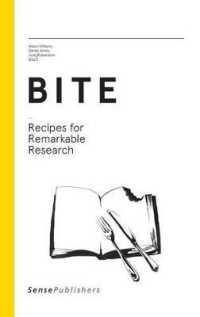- ホーム
- > 洋書
- > 英文書
- > Nature / Ecology
Full Description
This book comprehensively reviews the transformative potential of genome editing in insect pest management. The introductory chapter explores the importance of genome sequencing and its role in understanding pest biology and control. The subsequent chapters provide a thorough examination of CRISPR/Cas9 and other genome editing tools, discussing ethical and regulatory aspects. The following chapters introduce precision pest control strategies, including gene drive technologies and enhanced sterile insect techniques, and discuss integrating omics into integrated pest management (IPM) strategies. Sterile Insect Technique (SIT) enhanced with genome editing, its limitations, and various applications in pest control are discussed. The final chapter reviews the challenges, ethical considerations, risk assessment, safety protocols, biosecurity measures, the need for regulatory frameworks, and international cooperation in genome editing for pest management. As such, this book is a valuable source for scientists, researchers, and professionals in the fields of entomology, genetics, and agricultural science.
Key features:
Explores the role of omics technologies such as genomics, transcriptomics, proteomics, and metabolomics for pest management
Delves into RNAi in pest management, discussing its role in target identification and validation for pest gene control
Highlights the cutting-edge tools such as CRISPR/Cas9, ZFNs, and TALENs and their applications in pest control
Discusses innovative strategies such as gene drive technologies and the enhanced Sterile Insect Technique (SIT), and their integration into Integrated Pest Management
Addresses the ethical, safety, and regulatory challenges associated with genome editing in pest management
Contents
Chapter 1. Introduction to Genome Editing in Insect Pest Control. Chapter 2. Omics Technologies in Pest Management. Chapter 3. Genomic Insights into Insect Pests. Chapter 4. In-depth Exploration of CRISPR-Cas9 and Other Genome Editing Tools. Chapter 5. RNA Interference in Insect Pest Management. Chapter 6. Precision Pest Control Strategies.Chapter 7. Challenges and Ethical Considerations. Chapter 8. Future Directions and Emerging Technologies. Chapter 9. Case Studies in Sustainable Pest Control. Chapter 10. Sterile Insect Technique (SIT) Enhanced with Genome Editing.Chapter 11. Molecular Tools for Sustainable Agriculture: Harnessing the Power of ZFNs and TALENs in Pest Management Genomic. Chapter 12. Practical Implementation and Challenges. Chapter 13. Navigating Risks and Safeguarding Safety in Genome Editing and Omics for Pest Management. Chapter 14. Future Directions and Emerging Technologies







